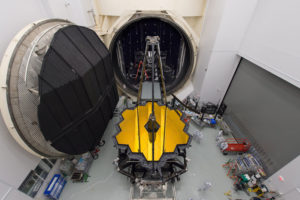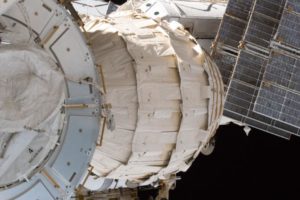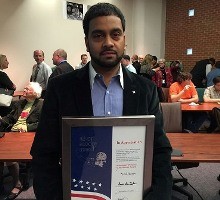Category Archives: Aerospace
SpaceX launch of Iridium-6/GRACE-FO Vandenberg Air Force Base, CA
Spacex HISPASAT 30W-6 Mission
How to build a Rocket to Mars
SpaceX Falcon Heavy Test Flight Replay
Webb’s First Space Targets chosen

Gas giant Jupiter, organic molecules in star-forming clouds and baby galaxies in the distant Universe are among the first targets for which data will be immediately available from the James Webb Space Telescope once it begins casting its powerful gaze on the Universe in 2019.
Thirteen “early release” programmes were chosen from more than 100 proposals after a competitive peer-review selection process within the astronomical community. The programmes have been allocated nearly 500 hours of observing time and will exercise all four of Webb’s state-of-the-art science instruments.
The data will be made publicly available immediately, showcasing the full potential of the observatory and allowing astronomers to best plan follow-up observations.
Webb is an international partnership between NASA, ESA and the Canadian Space Agency. As well as providing the Ariane rocket that will launch the observatory in 2019, Europe is contributing to two of the four scientific instruments.
Four of the first sets of observations announced today are led by scientists from ESA member states.
“We were impressed by the high quality of the proposals received. These programmes will not only generate great science, but will also be a unique resource for demonstrating the investigative capabilities of this extraordinary observatory to the worldwide scientific community,” says Ken Sembach, director of the Space Telescope Science Institute (STScI) in Baltimore, Maryland.
“We want the research community to be as scientifically productive as possible, as early as possible, which is why I am so pleased to be able to dedicate nearly 500 hours of director’s discretionary time to these early release science observations.”
“It is exciting to see the engagement of the astronomical community in designing and proposing what will be the first scientific programmes for the James Webb Space Telescope,” says Alvaro Gimenez, ESA Director of Science.
“Webb will revolutionise our understanding of the Universe and the results that will come out from these early observations will mark the beginning of a thrilling new adventure in astronomy.”
During its mission of a minimum of five years Webb will address key topics in modern astronomy, probing the Universe beyond what its precursor, the Hubble Space Telescope, can see.
Its observing goals include detecting the first galaxies in the Universe and following their evolution over cosmic time, including ‘weighing’ supermassive black holes that lurk in their centres. It will build on observations made by the Hubble Space Telescope, examining galaxies whose light has been stretched into infrared wavelengths by the expansion of space – beyond what Hubble can see – giving astronomers new insights into these galaxy cornucopias.
Webb will also witness the birth of new stars and their planetary systems, and study planets in our Solar System and around other stars to better understand the origin of life here on Earth.
The space observatory will be able to analyse the composition of exoplanet atmospheres, which could provide hints of a planet’s potential habitability.
Astronomers will initially train their gaze onto gaseous Jupiter-sized worlds, which will pave the way for studies of smaller super-Earths.
NASA May Extend BEAM’s Time on the International Space Station

NASA is exploring options with Bigelow Aerospace to extend the life of the privately owned Bigelow Expandable Activity Module. Known as BEAM, the module is attached to the International Space Station and continues to perform well during its technology demonstration mission. NASA has issued a synopsis of an intended contract action to partner with Bigelow Aerospace to extend the life of the expandable habitat and use it for long-term in-orbit storage. This step continues NASA’s commitment to expand private-public partnerships, scientific research and commercial applications aboard station to maximize the benefits from humanity’s premiere laboratory in microgravity.
NASA’s use of BEAM as part of a human-rated system will allow Bigelow Aerospace to demonstrate its technology for future commercial applications in low-Earth Orbit. Initial studies have shown that soft materials can perform as well as rigid materials for habitation volumes in space and that BEAM has performed as designed in resistance to space debris.
BEAM launched on the eighth SpaceX Commercial Resupply Service mission in 2016. After being attached to the Tranquility Node using the station’s robotic Canadarm2, it was filled with air to expand it for a two-year test period to validate overall performance and capability of expandable habitats. Since the initial expansion, a suite of sensors installed by the crew automatically take measurements and monitor BEAM’s performance to help inform designs for future habitat systems. Learning how an expandable habitat performs in the thermal environment of space and how it reacts to radiation, micrometeoroids and orbital debris will provide information to address key concerns about living in the harsh environment of space. This extension activity will deepen NASA’s understanding of expandable space systems by making the BEAM a more operational element of the space station to be actively used in storage and crew operations.
Space station crew members have entered BEAM 13 times since its expansion in May 2016. The crew has conducted radiation shielding experiments, installed passive radiation badges called Radiation Area Monitors, and they routinely collect microbial air and surface samples. These badges and samples are returned to Earth for standard microbial and radiation analysis at the Johnson Space Center.
The original plan called for engineers to robotically jettison BEAM from the space station following the two-year test and validation period, allowing it to burn up during its descent through Earth’s atmosphere. However, after almost a year and a half into the demonstration with positive performance, NASA now intends to continue supporting BEAM for stowage use and to allow Bigelow Aerospace to use the module as a test-bed for new technology demonstrations. A new contract would likely begin later this year, overlapping the original planned test period, for a minimum of three years, with two options to extend for one additional year. At the end of the new contract, the agency may consider further life extension or could again consider jettisoning BEAM from the station.
Using the space inside BEAM would allow NASA to hold between 109 to 130 Cargo Transfer Bags of in-orbit stowage, and long-term use of BEAM would enable NASA to gather additional performance data on the module’s structural integrity, thermal stability and resistance to space debris, radiation and microbial growth to help NASA advance and learn about expandable space habitat technology in low-Earth orbit for application toward future human exploration missions. Given that the volume of each Cargo Transfer Bag is about 1.87 cubic feet (0.53 cubic meters), use of BEAM for stowage will free an equivalent space of about 3.7 to 4.4 International Standard Payload Racks, enabling more space in the ISS for research.
With an extension of the partnership, Bigelow also would be able to continue to demonstrate its technology for future commercial applications in low-Earth orbit. The public-private partnership between NASA and Bigelow supports NASA’s objective to develop deep space habitation capabilities for human missions beyond Earth orbit while fostering commercial capabilities for non-government applications to stimulate the growth of the space economy.
Source: NASA
Elon Musk, SpaceX CEO addresses IAC Congress in Adelaide, Australia
This week at the International Astronautical Congress (IAC) in Adelaide, Australia, SpaceX CEO and Lead Designer Elon Musk will provide an update to his 2016 presentation regarding the long-term technical challenges that need to be solved to support the creation of a permanent, self-sustaining human presence on Mars.
NASA’s Voyager Spacecraft Still Reaching for the Stars After 40 Years

Humanity’s farthest and longest-lived spacecraft, Voyager 1 and 2, achieve 40 years of operation and exploration this August and September. Despite their vast distance, they continue to communicate with NASA daily, still probing the final frontier.
Their story has not only impacted generations of current and future scientists and engineers, but also Earth’s culture, including film, art and music. Each spacecraft carries a Golden Record of Earth sounds, pictures and messages. Since the spacecraft could last billions of years, these circular time capsules could one day be the only traces of human civilization.
“I believe that few missions can ever match the achievements of the Voyager spacecraft during their four decades of exploration,” said Thomas Zurbuchen, associate administrator for NASA’s Science Mission Directorate (SMD) at NASA Headquarters. “They have educated us to the unknown wonders of the universe and truly inspired humanity to continue to explore our solar system and beyond.”
The Voyagers have set numerous records in their unparalleled journeys. In 2012, Voyager 1, which launched on Sept. 5, 1977, became the only spacecraft to have entered interstellar space. Voyager 2, launched on Aug. 20, 1977, is the only spacecraft to have flown by all four outer planets — Jupiter, Saturn, Uranus and Neptune. Their numerous planetary encounters include discovering the first active volcanoes beyond Earth, on Jupiter’s moon Io; hints of a subsurface ocean on Jupiter’s moon Europa; the most Earth-like atmosphere in the solar system, on Saturn’s moon Titan; the jumbled-up, icy moon Miranda at Uranus; and icy-cold geysers on Neptune’s moon Triton.
Though the spacecraft have left the planets far behind — and neither will come remotely close to another star for 40,000 years — the two probes still send back observations about conditions where our Sun’s influence diminishes and interstellar space begins.
Voyager 1, now almost 13 billion miles from Earth, travels through interstellar space northward out of the plane of the planets. The probe has informed researchers that cosmic rays, atomic nuclei accelerated to nearly the speed of light, are as much as four times more abundant in interstellar space than in the vicinity of Earth. This means the heliosphere, the bubble-like volume containing our solar system’s planets and solar wind, effectively acts as a radiation shield for the planets. Voyager 1 also hinted that the magnetic field of the local interstellar medium is wrapped around the heliosphere.
Voyager 2, now almost 11 billion miles from Earth, travels south and is expected to enter interstellar space in the next few years. The different locations of the two Voyagers allow scientists to compare right now two regions of space where the heliosphere interacts with the surrounding interstellar medium using instruments that measure charged particles, magnetic fields, low-frequency radio waves and solar wind plasma. Once Voyager 2 crosses into the interstellar medium, they will also be able to sample the medium from two different locations simultaneously.
“None of us knew, when we launched 40 years ago, that anything would still be working, and continuing on this pioneering journey,” said Ed Stone, Voyager project scientist based at Caltech in Pasadena, California. “The most exciting thing they find in the next five years is likely to be something that we didn’t know was out there to be discovered.”
The twin Voyagers have been cosmic overachievers, thanks to the foresight of mission designers. By preparing for the radiation environment at Jupiter, the harshest of all planets in our solar system, the spacecraft were well equipped for their subsequent journeys. Both Voyagers carry redundant systems that allow the spacecraft to switch to backup systems autonomously when necessary, as well as long-lasting power supplies. Each Voyager has three radioisotope thermoelectric generators, devices that use the heat energy generated from the decay of plutonium-238 — only half of it will be gone after 88 years.
Space is almost empty, so the Voyagers are not at a significant level of risk of bombardment by large objects. However, Voyager 1’s interstellar space environment is not a complete void. It’s filled with clouds of dilute material remaining from stars that exploded as supernovae millions of years ago. This material doesn’t pose a danger to the spacecraft, but is a key part of the environment that the Voyager mission is helping scientists study and characterize.
Because the Voyagers’ power decreases by four watts per year, engineers are learning how to operate the spacecraft under ever-tighter power constraints. And to maximize the Voyagers’ lifespans, they also have to consult documents written decade’s earlier describing commands and software, in addition to the expertise of former Voyager engineers.
“The technology is many generations old, and it takes someone with 1970s design experience to understand how the spacecraft operate and what updates can be made to permit them to continue operating today and into the future,” said Suzanne Dodd, Voyager project manager based at NASA’s Jet Propulsion Laboratory in Pasadena.
Team members estimate they will have to turn off the last science instrument by 2030. However, even after the spacecraft go silent, they’ll continue on their trajectories at their present speed of more than 30,000 mph (48,280 kilometers per hour), completing an orbit within the Milky Way every 225 million years.
The Voyager spacecraft were built by JPL, which continues to operate both. The Voyager missions are part of the NASA Heliophysics System Observatory, sponsored by the Heliophysics Division of the Science Mission Directorate.
Source: NASA
Honeywell Engineer Awarded Prestigious NASA Silver Snoopy Award

Honeywell Engineer Syed Hasan has been awarded the prestigious Space Flight Awareness Silver Snoopy Award by NASA which recognizes outstanding achievements related to human flight safety or mission success.
Astronaut Anna Lee Fisher presented Hasan with the award at a ceremony at the agency’s Goddard Space Flight Center in Maryland this week. The award, which is given out to NASA employees or contractors, honors the contributions made toward enhancing the probability of mission success, improvements in design, administrative/technical/production techniques, business systems, flight and/or systems safety or identification and correction or preventive action for errors. The award consists of a silver “Snoopy” lapel pin flown during a NASA mission, a commendation letter, and a signed certificate. Hasan’s pin was flown aboard a 2006 Space Shuttle Mission to the International Space Station.
Hasan, a 10-year Honeywell veteran, is the Lead Collision Avoidance Engineer for the Earth Observing System missions (Terra, Aqua and Aura) at NASA Goddard Space Flight Center in Greenbelt, MD. He was nominated for his dedication, commitment, and outstanding support to the Space Flight program while working in the Flight Dynamics Facility as the Human Space Flight lead. He played a major role in the success of the early SpaceX Commercial Orbital Transportation Services (COTS) Demo Flights. Syed developed a process improvement in tracking the unmanned SpaceX Dragon cargo spacecraft during reentry. His process, which involved a more efficient way to process SpaceX-provided trajectory data, yielded better tracking and better communication with the spacecraft on re-entry. Post mission, SpaceX reported highly improved tracking results and expressed their pleasure with the performance of the new support method.
Aerospace, Defense, Space